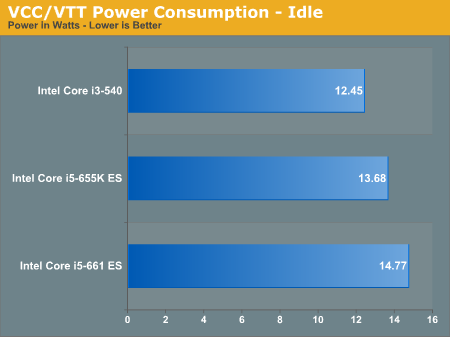Intel’s Core i5-655K & Core i7-875K: Overclocked and Analyzed
by Rajinder Gill on May 28, 2010 5:00 AM ESTHere's the idle/full load power consumption figures at stock speeds. VCC and VTT only, with VRM switching efficiency factored out:


Now that we've got these figures as a reference point. We can start looking at how each processor reacts to over-frequency conditions and how this affects factors such as heat and stability.
The following graph shows processor power scaling versus frequency, using Linpack to load the cores – highlighting the maximum Stock VID overclock and the maximum overall overclock using the Intel heatsink:

Using the BCLK method of overclocking (increasing the frequency of every associated bus), the power consumption ramp between 3.33GHz and 3.77 GHz is a mere 4 Watts at stock VID on our i5-655K – that’s why overclocking at stock voltages is wise if you’re working within the confines of stock cooling or concerned for processor longevity. In fact, only a small change in voltage is required to reach the 4GHz mark, coming in at a very sensible 7 Watt rise over stock power draw.
Over 4GHz, we see a sharp hike in power draw for every 20MHz increase in frequency, and by the time we get to 4.127GHz we’re tapped out on the stock Intel cooler. Increasing voltage at this point does not help, and we start seeing uncorrectable errors during Linpack. At this point, we need better cooling to extend our overclocking headroom. Before we experiment with improved cooling though, its worth taking a look at how things compare to a retail i3-540 using Intel’s stock heatsink.










51 Comments
View All Comments
ehume - Friday, October 8, 2010 - link
I finally got around to getting the 875k. Using the brand new Real Temp 3.60, I can now adjust the Turbo Boost multipliers so that under load all four cores go to 30x. That means with a bclk of 134MHz I now see a cpu clock range from 1206MHz on idle to 4020MHz on load. Nice.But Intel advertised an adjustable memory multiplier as well. Since my memory is rated at DDR3-2000 I would like to push it beyond the 1608MHz that 12x134 allows. So, is it possible to push the memory multiplier beyond 12x? Does the 875k have that in it?
I have checked a number of reviews and found nothing other than a repetition of Intel's statements that the memory multiplier is unlocked. Well, is it?